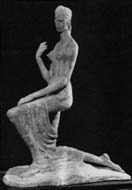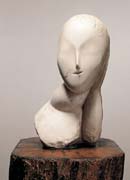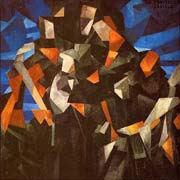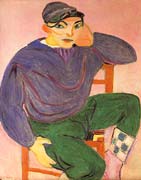page4 |
 |
 |
Marcel
Duchamp: Armory Show Lecture, 1963
recorded
by Richard N. Miller
| click
to enlarge |
 |
| Figure
24 |
| Wilhelm
Lehmbruck, Kneeling Woman (Femme á genoux), 1911 |
|
Figure
25
André Derain, Window on the Park (La Fênetre sur le parc),
1912 |
Lehmbruck. Wilhelm Lehmbruck has been called the leading Expressionist
sculptor. In this Kneeling Woman (Fig. 24) of 1910,
he is simply turning away, turning his back on the pure forms of Maillol,
whose influence had marked his earlier years. The plaster cast of
this sculpture was in the original show in 1913 and belongs now to
the Albright Gallery in Buffalo. But it is too fragile, really, to
travel. You can only see it this way.
Derain. One of the original “wild beasts,” the Fauves,
with Matisse and Braque. Derain turned, after 1907, to a more constructive
technique. Almost a Cubist, without accepting to be a Cubist. He
was very stubborn, too. And his still life, Window on the Park
(Fig. 25), 1912 belongs to the Museum of Modern
Art in New York, was in the original Show, and is also in the present
show.
Pablo Picasso. This portrait of Madame Soler is a very early
Picasso, dated 1903. It belongs to the blue period, probably painted
in Barcelona, where he had returned after his first stay in Paris,
1901-1902. One of the very first Cubist sculptures by Picasso, this
Head of Fernande Olivier, 1909, is treated with the
same facet-like technique as were the Cubist paintings of the same
year. Yes, it’s in the present show. It’s upstairs.
Beautiful sculpture. Now, we have another one, which is called Woman
with a Mustard Pot (Fig. 26), you see the mustard
pot on the left, and was painted in 1910, at the very beginning
of Cubism, and bears a certain resemblance to the sculpture you just
saw on the screen. The museum of The Hague, Holland, agreed to lend
this important painting to the show in New York in April. They wouldn’t
let it go for more than three weeks, I don’t know why. The
three Picassos you just saw were all in the original Show.
Now, this is Brancusi. Constantin Brancusi. I cannot understand
why this beautiful Muse (Fig. 27) and four other sculptures
of Brancusi’s, created such a violent reaction in the Chicago
show of 1913. As a result, Brancusi was burned in effigy, along with
Matisse and Walter Pach, in Chicago (laughter). It’s
true. These are the mysteries of modern art.
Braque. Georges Braque, in 1908, Georges Braque abandoned his Fauvist
palette and attacked a completely different problem, which was to
become Cubism. This still life, Pitcher and Violins (Fig.
28), 1910, is typical of the first years of the Cubist
discipline as it was practiced by Picasso and Braque at that time.
In fact, their technique was so closely similar that it was very difficult
at times to distinguish the Cubist Braque from the Cubist Picasso.
That I know, that was very difficult.
Léger. Fernand Léger. I remember seeing this composition by Léger
in the Cubist room of the Salon d’Automne in 1911. Léger’s
contribution to Cubism in 1910 and 1911 was this tubular style. Instead
of using cubes, he used tubes. The art critics of the time called
him a Tubist instead of a Cubist (laughter). It’s true,
it was in all the papers. He was soon to develop a more colorful
style.
La Fresnaye. La Fresnaye. Roger de la Fresnaye was wrongly called
a Cubist. In this Village of Meulon of 1912,
he simply applies a geometric technique, a formal transcription of
a very effective landscape. This painting is now in the Philadelphia
Museum of Art in the Arensburg collection, and probably was in the
1913 Show. Probably. When I first came to New York in 1915, it was
hanging in the Arensburgs’ dining room. They probably bought
it at the Show, that’s why.
|
click images to enlarge
|
 |
 |
|
| Figure
26 |
Figure
27 |
Figure
28 |
|
Pablo Picasso, Woman with Mustard Pot (La Femme au pot de
moutarde), 1910 |
Constantin Brancusi, The Muse (La Muse), 1912,
Solomon R. Guggenheim Museum, New York
|
Georges
Braque, Violin and Pitcher, 1910 |
| click
to enlarge |
 |
| Figure
29 |
| Francis
Picabia, Procession in Seville, 1912 |
Voila. It is Picabia. I also remember being in the studio with Picabia
in Paris when he was making this Cubist picture, Procession in
Seville (Fig. 29) in 1912. His main preoccupation at that
time was to advocate abstraction, and he must be counted with Kandinsky,
Kupka, and Mondrian as one of the pioneers of non-figurative art.
This painting was in the Armory Show and is also included in the anniversary
show.
That’s my brother. Duchamp-Villon. Not himself, no (laughter).
Duchamp-Villon, my brother, has three pieces in the present show.
This one, his fourth piece, called Girl of the Woods, was made
in 1910, I believe, a year before his head of Baudelaire and two years
before his Cubist horse. It is a terracotta cast of the original
plaster which was in the 1913 show. He died in November of 1918,
from the long illness he had contracted at the front in the First
World War.
| click
to enlarge |
 |
| Figure
30 |
| Henri
Matisse, The Young Sailor, II (Jeune Marin), 1906 |
Now we come to Matisse, who I have been keeping for the last because
I want to show you five important ones, although we haven’t
got many upstairs. Matisse was represented in the Armory Show by
thirteen paintings, three drawings, and a large sculpture. While
Augustus John had thirty-eight, and Odilon Redon forty. But Matisse
had a big share of angry hostility on the part of the public and the
art critics. Even though we’re now completely familiar with
the five Matisses I’ll show you, we can imagine the shock they
produced in 1913 on a public totally unaware of the “Wild Beast
School,” the Fauves. This painting, The Young Sailor
(Fig. 30) was done in 1906, in Collioure. It is the second
of two versions, this more graceful and assertive than the first one.
Now, the Blue Nude of 1907 painted also in Collioure, heavily
accented in the Fauve style. It is now in the Baltimore Museum.
This is Luxe, the second version of 1908. It has only the
word “luxe” in common with an earlier painting of 1904-5
called Luxe, Calme, et Volupté, a title taken from the famous
poem of Baudelaire, L’Invitation au Voyage. It is completely
painted in Pointillist technique—the other one, not this one.
Girl with a Black Cat. This is one of the numerous portraits
Matisse made of his daughter Marguerite. It is dated 1910, a year
of many Matisse portraits. And now, the last slide, The Red Studio,
one of the four large interiors painted by Matisse in 1911. Against
a monochrome red, Matisse has scattered the colored miniature images
of his own paintings and sculptures. This last painting belongs to
the Museum of Modern Art in New York.
And now, before
we part, I would like to salute a few artists, veterans of the Armory
Show. Archipenko, Georges Braque, Paul Burlin, Stuart Davis, Edward
Hopper, Leon Kroll, Picasso, Monsieur [inaudible], Charles Sheeler,
Jacques Villon, Walkowitz, Margaret and William Zorach, and myself.
(Applause)
Announcer:
Lights!
(Applause)
[inaudible]
[cut]
Voice:
Questions and answers – we’re never gonna get those.
[inaudible]
Marcel Duchamp:
Yes. I don’t know because what you do in 1913 you don’t
do in 1963, even anybody. It is very difficult to say. I might and
might not. I don’t know, I couldn’t tell. And you don’t
know either. I have a cigar now (laughter and applause). Thank
you.
[end of recording]
page
1 2 3
4
|